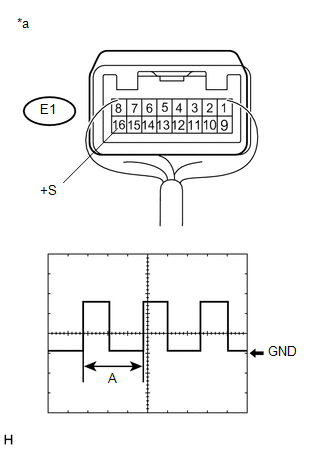Toyota Venza: Vehicle Speed Signal Circuit between Radio Receiver and Combination Meter
DESCRIPTION
- This circuit is necessary for the Automatic Sound Levelizer (ASL) built
into the radio and display receiver assembly.
The Automatic Sound Levelizer (ASL) function automatically adjusts the audio system volume level in order to compensate for increased vehicle noise (vehicle noise tends to increase as vehicle speed increases). The ASL adjusts the volume level based on vehicle speed signals sent from the combination meter assembly.
- Vehicle speed signals are sent from the combination meter assembly and
used to cancel "Bluetooth" function operation.
The radio and display receiver assembly recognizes that the vehicle is being driven and makes it impossible to connect or register a "Bluetooth" device while driving.
HINT:
- A voltage of 12 V or 5 V is output from each ECU and then input to the combination meter assembly. The signal is changed to a pulse signal at the transistor in the combination meter assembly. Each ECU controls its respective system based on this pulse signal.
- If a short occurs in any of the ECUs or in the wire harness connected to an ECU, all systems in the following diagram will not operate normally.
WIRING DIAGRAM
1. for 2GR-FE
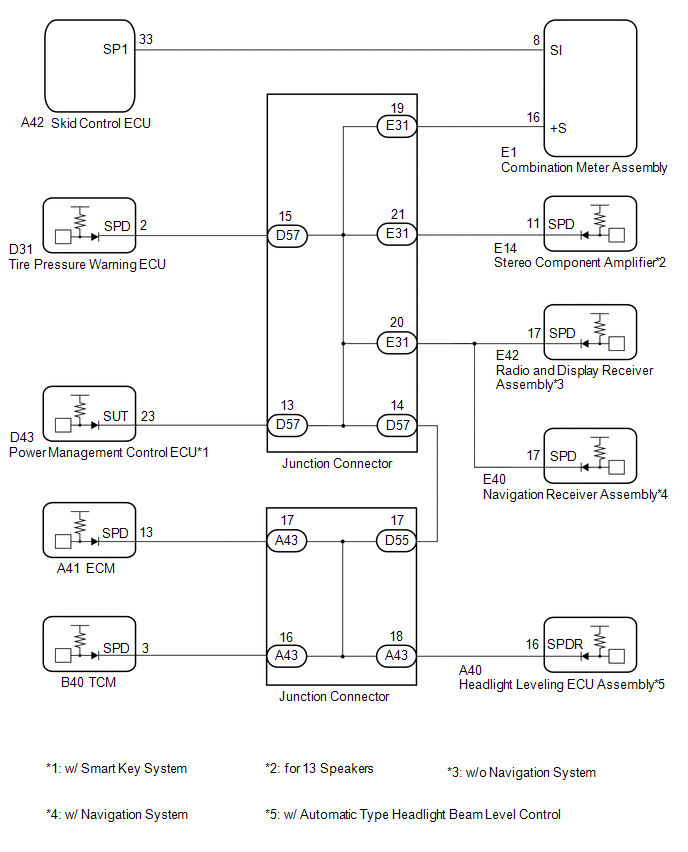
2. for 1AR-FE
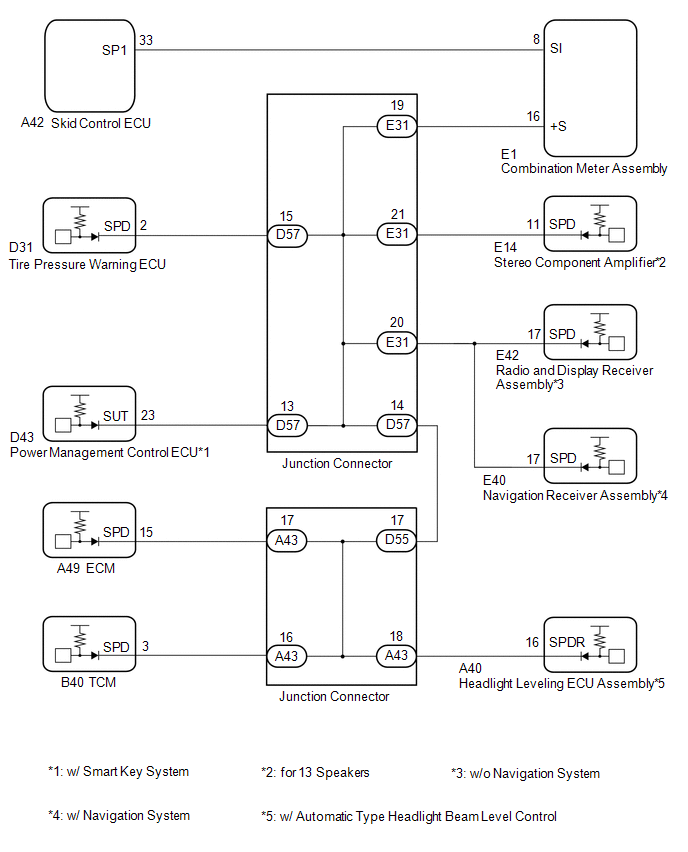
PROCEDURE
|
1. |
CHECK VEHICLE SIGNAL (OPERATION CHECK) |
|
(a) Enter the "Vehicle Signal Check Mode" screen. Refer to Check Vehicle
Signal in Operation Check (See page |
|
(b) While driving the vehicle, compare the value displayed for "SPEED" to the reading on the speedometer. Check if these readings are almost equal.
HINT:
The combination meter assembly receives the vehicle speed signal from the skid control ECU via CAN communication. Therefore, perform the following inspection referring to values on the Data List of the skid control ECU because it is the source of the vehicle speed signal.
OK:
Vehicle speed displayed on the "Vehicle Signal Check Mode" screen is almost the
same as the actual vehicle speed measured using the Techstream (See page
.gif) ).
).
| OK | .gif) |
PROCEED TO NEXT SUSPECTED AREA SHOWN IN PROBLEM SYMPTOMS TABLE |
|
|
2. |
INSPECT COMBINATION METER ASSEMBLY (OUTPUT WAVEFORM) |
|
(a) Check the output waveform. (1) Remove the combination meter assembly with the connector still connected. (2) Connect an oscilloscope to terminal E1-16 (+S) and body ground. (3) Turn the ignition switch to ON. (4) Turn a wheel slowly. (5) Check the signal waveform according to the condition(s) in the table below.
OK: The waveform is similar to that shown in the illustration. HINT: When the system is functioning normally, one wheel revolution generates 4 pulses. As the vehicle speed increases, the width indicated by (A) in the illustration narrows. Text in Illustration
|
|
| NG | .gif) |
GO TO METER / GAUGE SYSTEM |
|
|
3. |
INSPECT RADIO AND DISPLAY RECEIVER ASSEMBLY (INPUT WAVEFORM) |
(a) Check the input waveform.
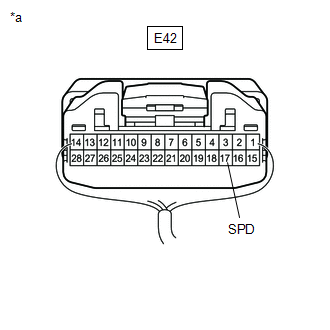
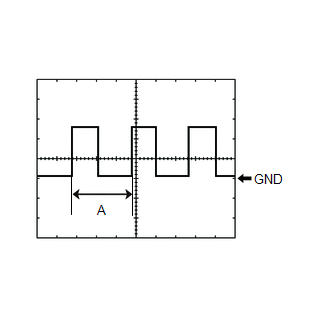
(1) Remove the radio and display receiver assembly with the connector still connected.
(2) Connect an oscilloscope to terminal E42-17 (SPD) and body ground.
(3) Turn the ignition switch to on.
(4) Turn a wheel slowly.
(5) Check the signal waveform according to the condition(s) in the table below.
|
Item |
Condition |
|---|---|
|
Measurement terminal |
E42-17 (SPD) - Body ground |
|
Tool setting |
5 V/DIV., 20 ms./DIV. |
|
Vehicle condition |
Wheel being rotated |
OK:
The waveform is similar to that shown in the illustration.
HINT:
When the system is functioning normally, one wheel revolution generates 4 pulses. As the vehicle speed increases, the width indicated by (A) in the illustration narrows.
Text in Illustration|
*a |
Component with harness connected (Radio and Display Receiver Assembly) |
| OK | .gif) |
REPLACE RADIO AND DISPLAY RECEIVER ASSEMBLY |
|
|
4. |
CHECK HARNESS AND CONNECTOR (RADIO AND DISPLAY RECEIVER ASSEMBLY - JUNCTION CONNECTOR) |
(a) Disconnect the E42 radio and display receiver assembly connector.
(b) Disconnect the E31 junction connector.
(c) Measure the resistance according to the value(s) in the table below.
Standard Resistance:
|
Tester Connection |
Condition |
Specified Condition |
|---|---|---|
|
E42-17 (SPD) - E31-20 |
Always |
Below 1 Ω |
| NG | .gif) |
REPAIR OR REPLACE HARNESS OR CONNECTOR |
|
|
5. |
CHECK HARNESS AND CONNECTOR (COMBINATION METER ASSEMBLY - JUNCTION CONNECTOR) |
(a) Disconnect the E1 combination meter assembly connector.
(b) Disconnect the E31 junction connector.
(c) Measure the resistance according to the value(s) in the table below.
Standard Resistance:
|
Tester Connection |
Condition |
Specified Condition |
|---|---|---|
|
E1-16 (+S) - E31-19 |
Always |
Below 1 Ω |
| OK | .gif) |
REPAIR OR REPLACE HARNESS OR CONNECTOR (JUNCTION CONNECTOR) |
| NG | .gif) |
REPAIR OR REPLACE HARNESS OR CONNECTOR |
 USB Audio System Recognition/Play Error
USB Audio System Recognition/Play Error
DESCRIPTION
When a USB device or "iPod" is connected to the USB jack of the No. 1 stereo
jack adapter assembly, it must have playable files. The device must also communicate
with and be ...
 Steering Pad Switch Circuit
Steering Pad Switch Circuit
DESCRIPTION
This circuit sends an operation signal from the steering pad switch assembly
to the radio and display receiver assembly.
If there is an open in the circuit, the audio system cannot be ...
Other materials about Toyota Venza:
Rear Left Center Sensor Malfunction (C1AE7)
DESCRIPTION
The No. 1 ultrasonic sensor (rear left center sensor) is installed on the rear
bumper. The ECU detects obstacles based on signals received from the No. 1 ultrasonic
sensor (rear left center sensor). If the No. 1 ultrasonic sensor (rear left ce ...
Installation
INSTALLATION
PROCEDURE
1. INSTALL FRONT SEAT ASSEMBLY
(a) Place the front seat assembly in the cabin.
NOTICE:
Be careful not to damage the vehicle body.
(b) Connect each connector under the front seat assembly.
(c) Temporarily install the front seat ass ...
Rear window wiper and washer
Type A
1. Off
2. Intermittent window wiper operation
3. Normal window wiper operation
4. Washer/wiper dual operation
5. Washer/wiper dual operation
Type B
1. Off
2. Intermittent window wiper operation
3. Normal window wiper operation
4. ...
0.1339

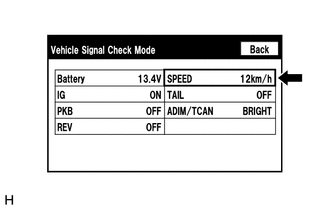
.gif)
